Muskego gardener lets nature take the lead for 1.25-acre backyard gardens
When Kayleigh Palmisano had her summer wedding reception in 2021 in the gardens of her parents’ home, all eyes were on the flowers.
It seems her father, Casey Palmisano, went a bit nuts over the years as he knew she would one day be married in their Muskego gardens.
“She was the inspiration. The yard was always a picturesque place that would draw a crowd for Kayleigh and her friends for special occasions. Then, when she was in about ninth grade, she mentioned how beautiful the yard was and said that someday she would like to get married here. So I thought I had better step it up a notch,” Casey said.
And he did.
He delved into gardening in such a big way that his 1.25-acre backyard is now filled with large and lush flowerbeds, shrubs and trees, meandering pathways, and seating areas that all front a large pond. His gardens will be featured in this year's Friends of the Muskego Library Garden Walk on June 24.
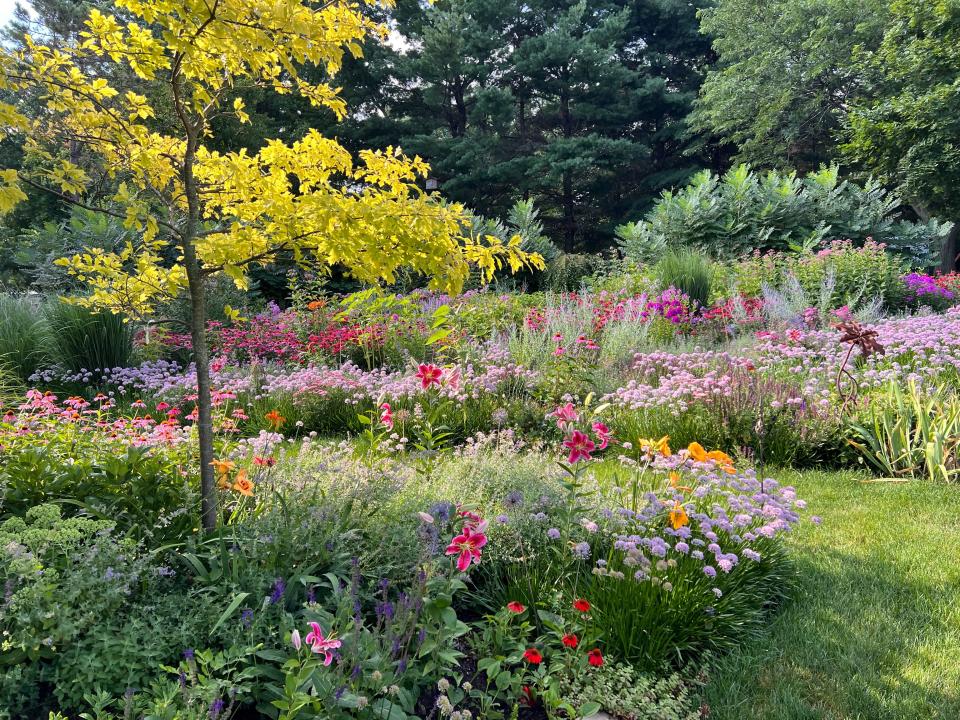
He also started a family landscaping business in 2020 called Bella Gardens (bellagardens.org). The Muskego firm focuses on transforming landscapes into natural, pollinator-friendly spaces that are beautiful and beneficial to the ecosystem.
Palmisano got started by researching different styles of gardening.
“I started researching plants and found a book by Roy Diblik (co-owner of Northwind Perennial Farm) called 'The Know Maintenance Perennial Garden,' and it became my big inspiration. I became obsessive about it,” he said.
He also started following Dutch garden designer Piet Oudolf, who is considered a leading figure of the New Perennial movement, also called the New Wave or the Dutch Wave, in which bold drifts of herbaceous perennials and grasses are chosen for their structure and color and are tightly spaced.
“By spacing them tightly, the plants outcompete the weeds. There is no space for weeds to grow.
“It’s about creating naturalistic meadows of plants and drawing inspiration from nature. ... The benefits are nothing short of extraordinary in that they require little maintenance. The gardens persist throughout fall and winter, providing wildlife habitat and foraging of seeds by birds throughout winter,” he said.
Armed with a bit of knowledge, he came up with a plan. But he didn’t necessarily follow the advice of those who initially inspired him.
His first garden bed was a former soccer field that measured about 40 feet wide and 60 feet long. For that bed he bought a variety of perennials and began planting them directly in the grass.
“I thought the grass would keep the weeds down, and it did, so in a way it did help me. I felt the plants would out compete the grass. That first fall you couldn’t see the grass, but by the next spring the grass grew really tall and I spent that first summer digging it out,” Palmisano said.
Because the space was so large he wasn’t able to buy as many plants as he needed to fill it, so he quickly learned to divide in order to conquer.
“No one can go to a garden center and say, for example, I need 4,000 allium. That’s the amount of that plant that I needed for the vision I had. ... That first year I had 70 allium. After I divided them after the first year, I had 700,” he said.
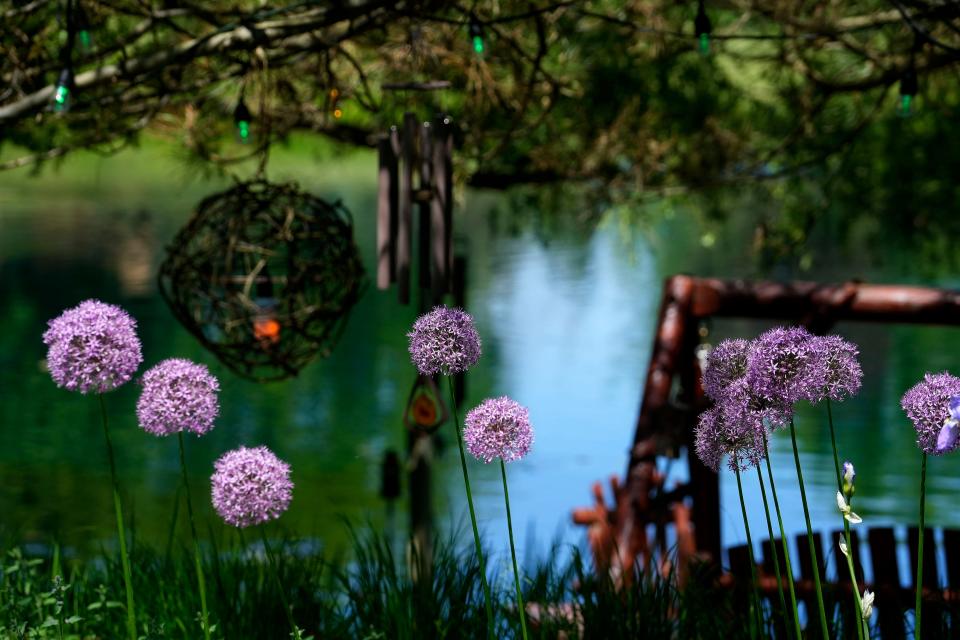
He estimated he now has 5,000 to 6,000 allium in that flowerbed and in other areas throughout his lot. He also divided the other plants in that first flowerbed and has used them in other areas.
“I slowly kept cutting the grass out and every year it became less persistent and I continued to divide my plants," he said. "I talked to Roy (Diblik) about this later and he said, ‘You did what?’ But by the third year it was completely full of flowers and that garden looked pretty amazing. But I did it the hard way, for sure.”
Soon he began creating more gardens; adding the plants he divided, and buying new ones. Throughout his space he focused on a small number of plants for a consistent look that provides lots of color.
There’s one area he calls the salvia garden that measures about 50 feet wide by 120 feet long with alliums, coneflowers and a “salvia river.”
“My salvia river is in an area that slopes down to the pond. It’s a long, thin space, about 10 to 15 feet wide, and about 120 feet long. It’s a mix of salvias, but Blue Hill and May Knight are the main ones.”
He said he planted the salvia river after seeing a similar garden done by Diblik at Lurie Garden (luriegarden.org) a naturalistic 2.5-acre garden in Chicago's Millennium Park.
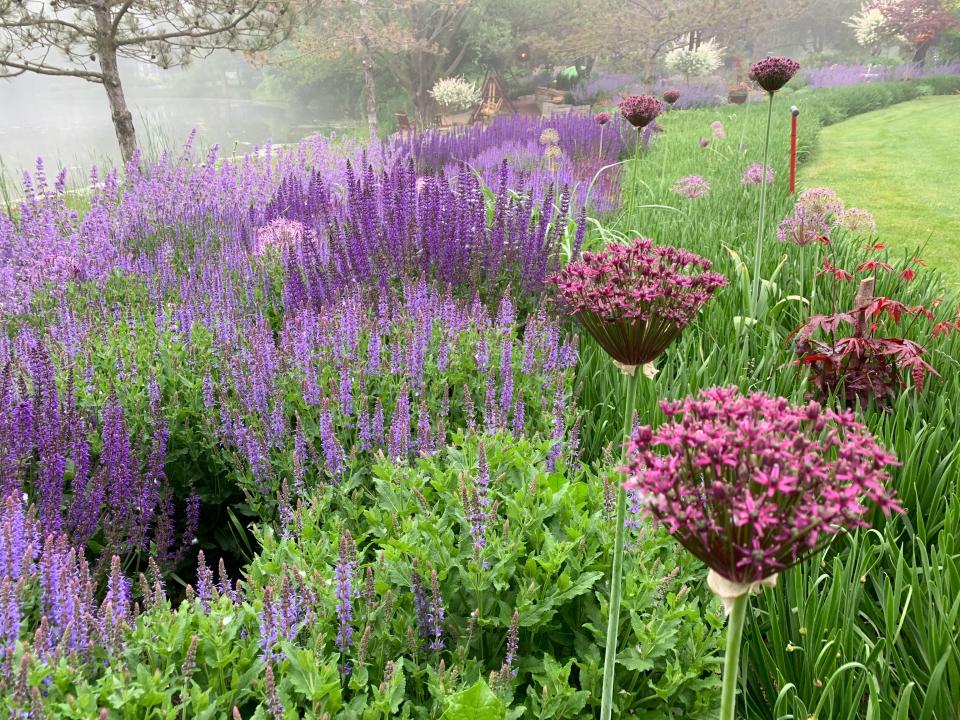
He also turned an area with Austrian pines into a walking path made with salmon Colorado flagstone, which also flanks the pond.
“The pines were one of the first things I planted and they were thinning out on the bottom, so I decided to put a walking path between them. When I got them I paid about $1 each. My wife called them Charlie Brown trees. Now they’re huge," he said.
Other gardens include the central garden, which has a majestic maple tree he planted years ago, along with mainly sedum, allium, astilbe and hostas. That space measures about 100 feet long by 30 feet wide.
There’s a shade garden behind a sitting area near the pond that’s filled with bleeding hearts, hostas and Japanese ferns, and a stretch of garden that runs along the pond that he’s left natural with Culver’s root, Joe Pye weed, Japanese iris and some cattails.
He also created small gardens throughout the property and a boxwood border around the former soccer field garden.
His most recent gardens were added just last summer.
“Moss expert Dale Siervert got me interested in moss gardens. I worked with him on some gardens so I could learn from him. I helped him with installations at Rose Innovations (owned by Will Radler who created the Knock Out series of roses), and at Kelton House Farm in Fredonia. I learned the type of mosses, their preferences, and their care through Dale,” he said.
He’s also started planting on a neighbor’s property.
“I ran out of room to garden so I started doing my neighbor’s yard. The moss garden is in my neighbor's yard, and I also put a large hosta walking path there," he said.
While he’s been gardening, he’s also been following nature's lead.
“What I’m keen on doing is listening to nature. ... When I wanted to make this a low maintenance garden, I planted, for instance, Japanese fern and I observed them to see if they worked in different spaces.
“No one takes care of the forest. The plants just grow because they find places that are natural for them. ... If you put plants where they are happy, you don’t need to fertilize and these plants don’t need to be mulched as the plant materials eventually break down and become their own mulch.”
He recently talked about his gardens and the upcoming tour.
Where does the name Bella Gardens come from?
From one of our cats. Her favorite activity is wandering around the yard. She has a route she takes any time she goes out here. We have two cats, Bella and ZuZu. We also have a new puppy, Elly, who is a goldendoodle.
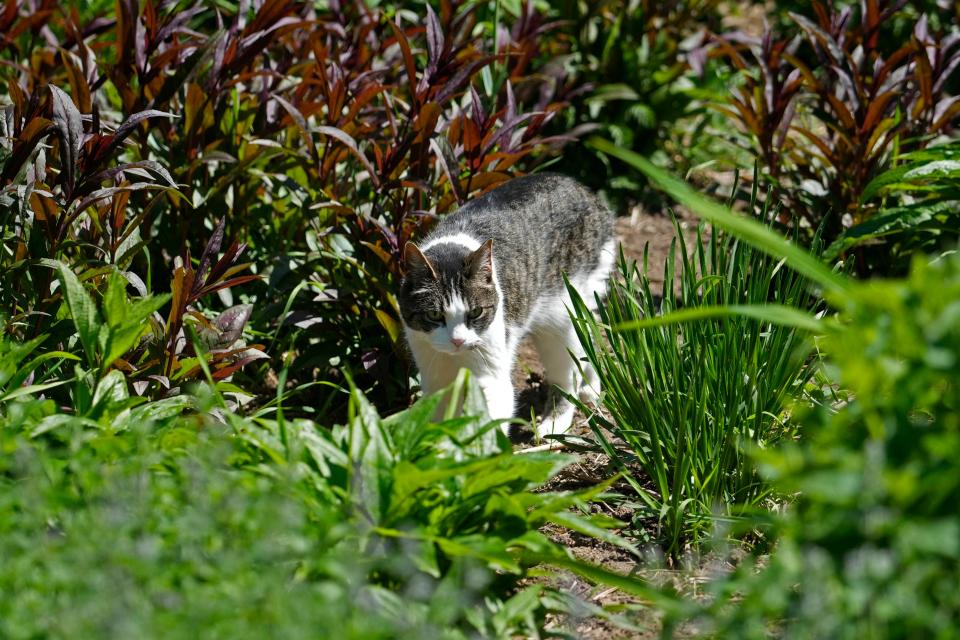
What do your family members do at Bella Gardens?
My wife, Kathie, is office manager and also creates cut flower bouquets for weddings and fundraisers. She’s also a social worker. My son Matthew is co-founder of Bella Gardens and manages the Chicago branch, my son Paul is the job site manager at the Milwaukee branch, and Kayleigh manages social media accounts, events, and does floral arrangements.
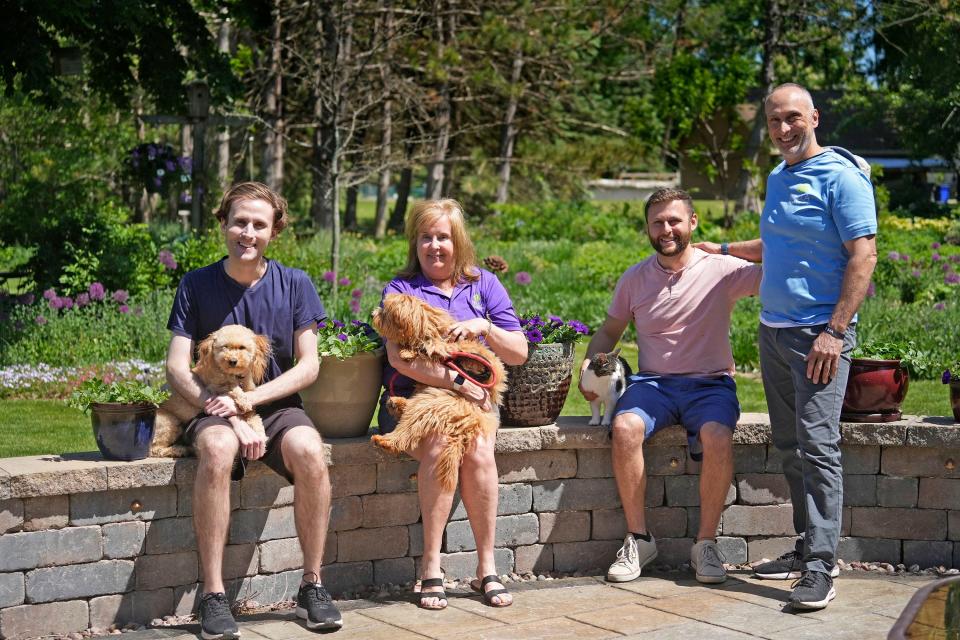
How much lead time did you have for your daughter's wedding reception?
Four days. But that was good because if I had more time I would have overthought things. But everything was in full bloom. It was a really small reception.
Did Kayleigh use flowers from the garden at the reception?
She did use them in the table arrangements.
What did your gardens look like when you first moved here?
When we bought this house in 1995 the landscape was pretty much a blank slate. The former owners had just planted a few trees and there was just grass.
What are the main plants you grow?
Catmint, allium, sedum, hostas, lilies and coneflowers.
Are all your plants perennials?
Some plants are biennials. I also have annuals in pots on the patio.
What are some of your favorite plants?
I love the whole class of alliums. I have all different kinds. By planting different kinds you can get constant blooms. I also like the nepetas (catmint). I especially like Nepeta Walker’s Low. I have 250 feet of catmint on one side of the yard. It’s a sterile variety so it doesn’t reseed. Some of the other varieties I have are the shorter varities, like Purrsian Blue Catmint or Kit Kat. Also sedum. I have many different varieties of them.
A shrub I like is staghorn sumac. Piet Oudolf grows that in the Netherlands and it’s a Wisconsin native. Also peucedanum verticallare or giant milk parsley. Roy Diblik got some from Oudolf and gave it to me. It gets 8 to 10 feet high and looks like a purple column. It’s pretty cool. It’s a biannual.
Do you still buy plants or just split them?
I only split them when I want to move them to a better location. But I also get them from other gardeners. A woman who lives in the area was just splitting her hostas and gave me some.
Do you have a lot of hostas? And are there favorites?
I probably have 50 to 60 varieties and maybe 300 plants. Some favorites are Frances Williams because of the multicolored look of the leaves. Also Krossa Regal and Fire Island.
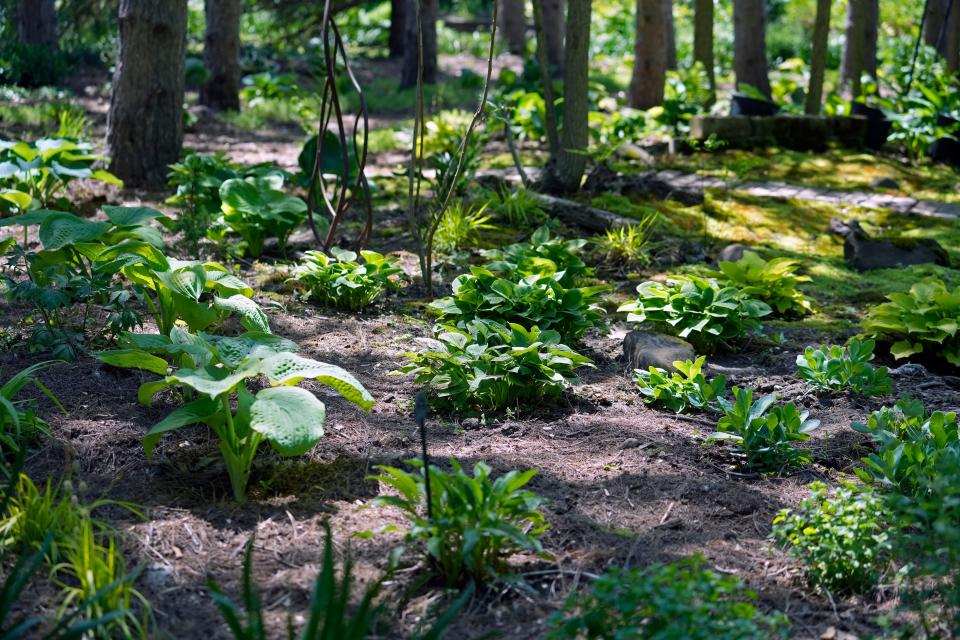
How big is your pond?
It’s about the size of a football field. It’s a manmade pond. There are only four other homes on it. Our lot is narrow at the front and wide at the back.
How much time do you spend working in your yard now that your gardens are so large?
I only spend 2 to 4 hours a week here during the growing season. My grass mowing time went from 1.25 hours to 15 minutes.
Can you describe your patio?
It’s 42 feet long and 22 feet wide and has a stamped concrete floor and a seat wall that’s 42 inches tall. We did the wall ourselves. It also has a fire pit in the center.
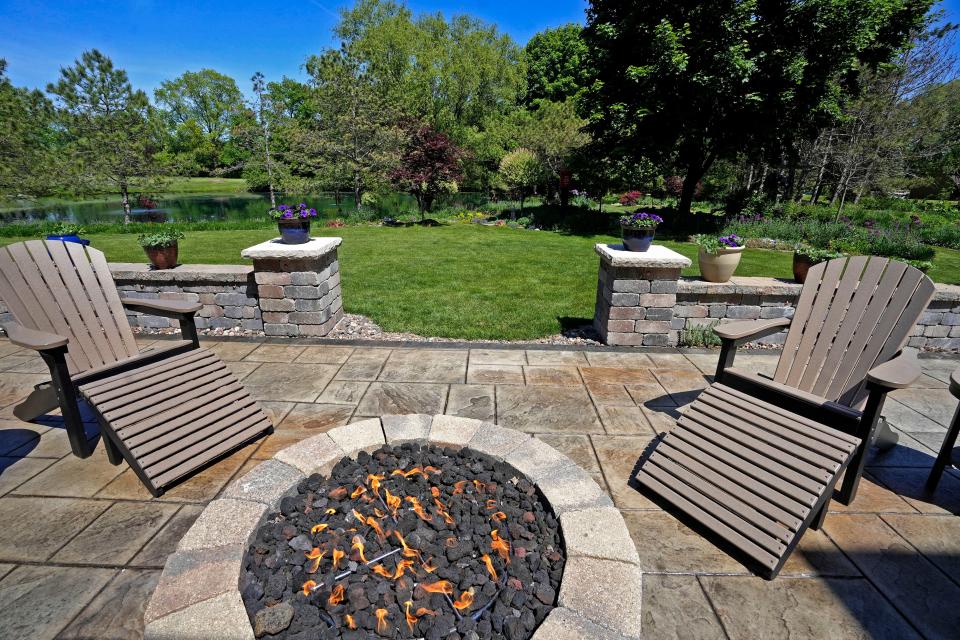
You’ve had beehives in the past. Will you have them this year?
No. I don’t want to have them this year because of the tour. But I’ll have them again next year. Right now I’m putting plants in that area that are pollinator- and bee-friendly. I still have honey from last year. I got 160 pounds.
How is the front of your home landscaped?
The kids say I must work on that next. I wanted the front to look simple. When you look at the house from the front, you can’t see anything in the back. My wife says that gives it a wow factor.
If you go
What: Friends of the Muskego Library Garden Walk tour of four gardens.
Where: In the Muskego area.
When: From 9 a.m. to 4 p.m. June 24.
Extras: Lectures by Rick Boyd of Rainforest Rick in Mequon, Paul Ruszkiewicz of Paul's Petal Pushers in Muskego and Waterford, and Jeff Trader, a Master Gardener volunteer in Brookfield who will give a talk titled “Gardening From a Wisconsin Point of View — Take Time to Smell the Roses.” There will also be a perennial plant sale, garden boutique, pre-owned art sale, garden-related craft fair, raffle baskets and a gift card raffle.
Tickets: Are $15; children 14 and under are free. Tickets can be purchased by cash, check or credit card with a slight service fee at the Muskego Library, S73 W16663 Janesville Road, or though the website.
More information: cityofmuskego.org/1008/2023-Garden-Walk
This article originally appeared on Milwaukee Journal Sentinel: Muskego gardener lets nature take the lead for 1.25-acre backyard

